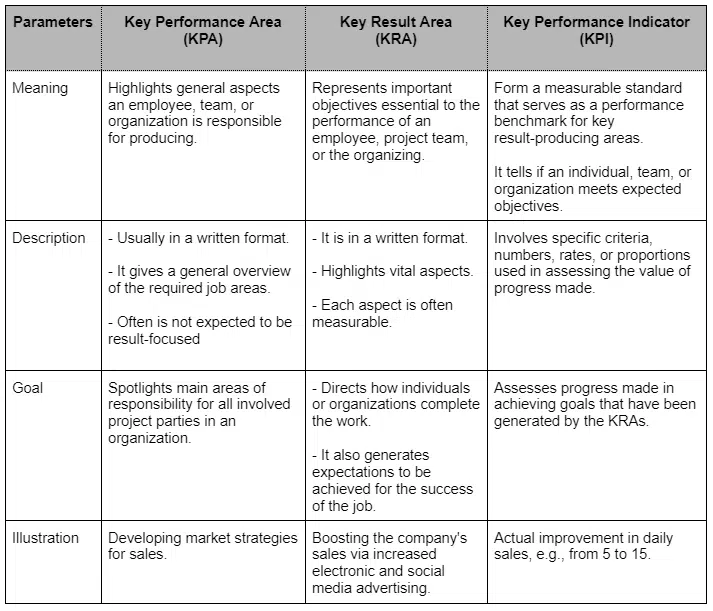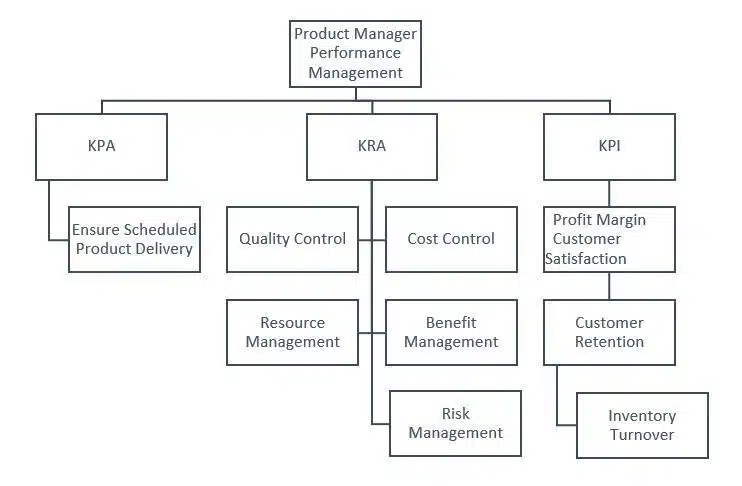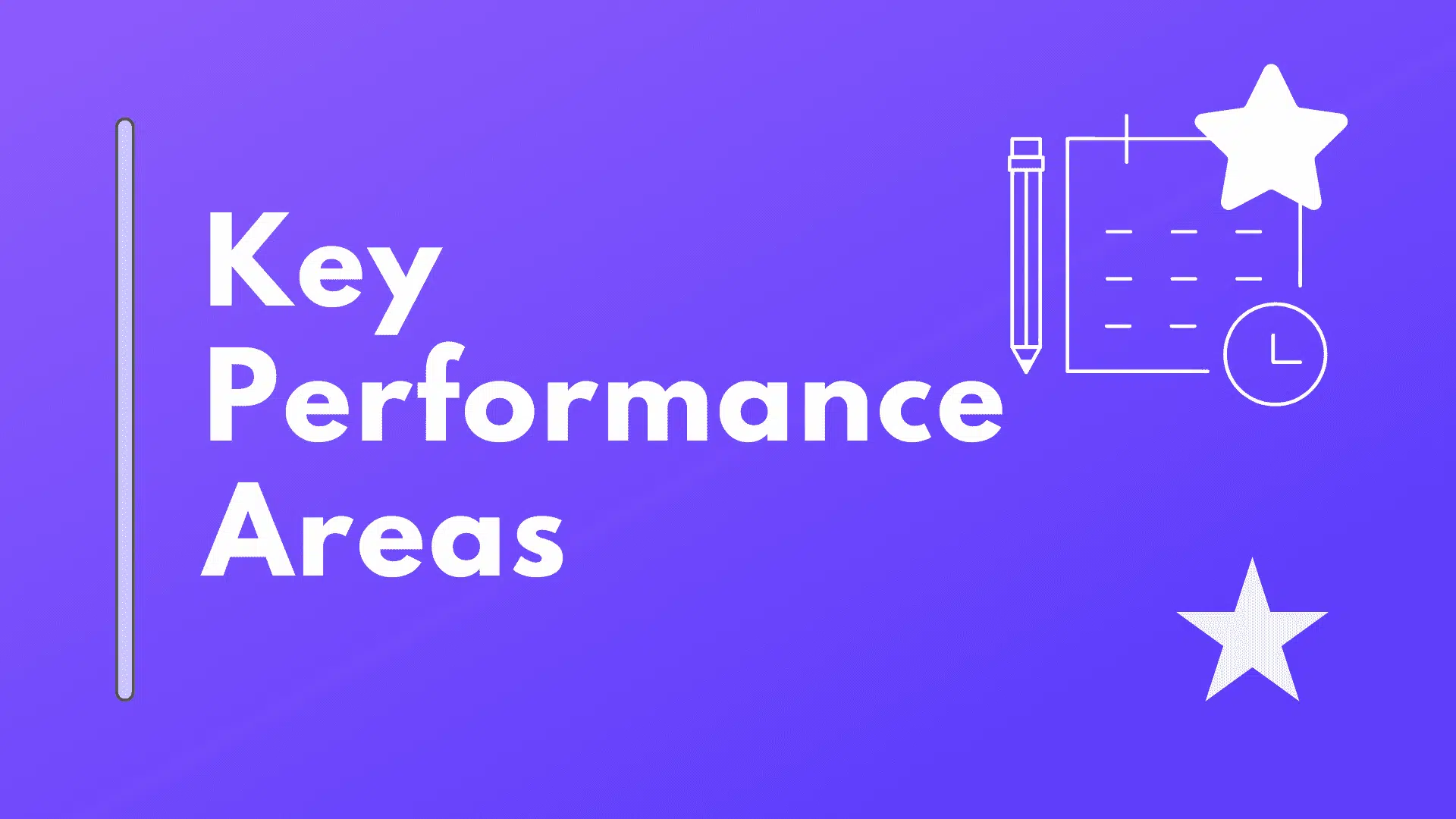Performance measurement is an integral part of project management that ensures the employees know their responsibilities and roles in completing the project.
Key Performance Area (KPA) is the key aspect that affects the project, and the project managers must know Key Performance Areas to emphasize them and complete the project successfully.
What Are Key Performance Areas?
Key Performance Areas (KPAs) highlight the general aspects for which an employee, project team, or organization is responsible.
KPAs are the range of tasks completed by an employee, department, or organization. It does not necessarily need to be result-oriented
You can see it as the job specifications of each employee that explain the expected roles and responsibilities.
For example, the project manager is responsible for completing the project with the stated quality, on time, and within budget.
KPAs can include the following depending on the type of project or organization:
Facilitative Working Domain
It ensures the team has favorable working conditions. Employees should enjoy the workplace and be passionate about their responsibilities. When employees are comfortable, they perform better.
Efficient Use of Resources
You should schedule the tasks according to resource availability and hire team members with the required skills and knowledge so they can perform the tasks efficiently with available resources. This KPA helps minimize resource wastage.
Upgrading Project Execution Methods
Organizations have broad goals. Ensuring the employee’s skills and responsibilities align with the organizational goal motivates employees and helps optimize productivity.
An example can be providing training to employees lacking in certain skills so they can perform better.
Minimizing Occupational Hazards and Promoting Work-Environment Safety
Workplace safety is vital. A safe workplace reduces risks, prevents incidents, and provides confidence and security to employees. The employee will feel safe and secure, and they will perform better.
This KPA helps boost risk management policies and ensures employees comply with rules and regulations.
Remodeling External Service-Level Agreements (ESLAs)
ESLA is an agreement between an organization and customers. It documents the standard of expected services.
The Service-Level Agreement checks the actions of an organization and keeps its performance streamlined to established terms and conditions while executing the project.
Types of Key Performance Areas
The KPAs can be of four types:
#1. The Aspect of Finance and Monetary Value: Here, you deal with areas related to generated revenue, expenditures, net profits realized, and financial trends which can impact the performance of individuals and departments.
This KPA is associated with the funding and how you generate and spend it to meet product creation demands.
#2. Clients’ Satisfaction: This KPA includes the number of customers satisfied with the products and services. It measures the extent to which a client’s expectations are met or exceeded. Feedback, surveys, reports, return or reorder rates, or the number of complaints, etc., are useful tools for this KPA.
Feedback helps improve the performance of the forthcoming iteration iterations, resulting in satisfied customers.
#3. Market Image: Market image impacts the organization’s performance, which is a vital KPA. High-quality products and prompt service affect the business’s brand image positively. In addition, repeated task completion creates mastery and puts an organization on a pedestal of excellence.
#4. Efficiency in Performance: This KPA shows how you meet goals and optimally achieve results using available resources. This KPA examines if a business is meeting the set milestones, progressing as planned, and keeping the client satisfied.
Differences between KPA, KRA, and KPI
Key Performance Areas (KPAs), Key Performance Indicators (KPIs), and Key Result Areas (KRAs) are performance measurement indices, and many experts confuse them with each other.
The following table shows the difference between these terms.

Finally, you can see KPAs as the main goals, KRAs as the objectives, and KPIs as the means to measure if they properly fulfilled the aims and objectives.
Benefits of Key Performance Areas
The following are the benefits of Key Performance Areas:
#1. Financial Evaluation: KPA ensures tasks have assignees, making cost estimation realistic.
You can measure the monetary parameters by comparing the estimated cost against the actual cost spent during the project life cycle.
When the spent cost is near the planned cost, the project is progressing in the right direction financially.
#2. Appreciates Accomplishments: KPAs provides an overview of expectation from the team or an organization. It is not necessarily result-oriented but serves as a general benchmark to determine if the project was successful.
It provides a sense of accomplishment, and employees will feel appreciated.
#3. Detects Deviation and Minimizes Distractions: Often, team members get distracted by unproductive tasks affecting the project objectives. As a result, these activities accumulate and waste time and effort.
The project environment can be tough, and team members may unconsciously deviate from their responsibilities.
KPAs check whether employees are sticking to the assigned task and performing as expected to stop deviation and minimize distractions.
#4. Identifies Sectors that Need Improvement: The KPAs reference the job description that helps identify areas requiring improvement. This enhances performance in the upcoming iteration.
Predictions will improve, and you can implement action plans to encourage better performance.
#5. Informs Organizational Decisions: KPAs help formulate policies and make decisions. KPAs shows who is responsible for what, this help detect areas where a policy review is required.
For instance, if any department needs more hands with specific skills, recruiting new employees will improve the performance and less exhausted workers.
KPAs help organizations’ distinct needs and wants, ensuring the organization makes the right decision and develops robust policy.
#6. Fosters Team-Building: When team members understand what you expect of them, there will be fewer conflicts regarding assignments and responsibilities, and they will collaborate well; this improves performance.
#7. Determines the Finish Line: A written job overview makes it possible to know when they have completed the tasks.
KPAs may not necessarily provide outcomes, but they give an individualized and/or generalized insight into task completion.
Examples of Key Performance Areas (KPA)
Here, we will see the KPA examples under three different scenarios.
Example: 1
Company A plans a new product line. The product manager’s roles and responsibilities are shown in the below diagram using KPAs, KRAs, and KPIs.

- KPA provides job descriptions for staff involved in the production chain. For example, in this illustration, the product manager’s goal is to ensure timely product delivery.
- Specific objectives vital to the organization’s performance become established, indicating the KRAs. Here, the product manager outlines areas to achieve desired objectives, such as product quality and cost control, resource, benefit, and risk management.
- Lastly, as part of performance measurement indices, specific measurement standards are used to determine if performance yielded optimal results. These are called KPIs and include measures to determine if end-users were satisfied with the product.
Example: 2
Performance Measurement for a procurement officer.
KPA:
- Get product orders for the organization at the appropriate time.
KRA:
- Ensure product suppliers comply with proposed contracts regarding organization consumables.
- Faster and efficient order placement processes.
- Ensuring the right orders are received.
KPI:
- Contracts compliance rate over a while.
- Waiting time to get product orders.
- The ratio of wrong/right orders.
Example: 3
Internal Audit
KPA:
- Perform regular audits.
KRA:
- Performing quality audits in essential areas
- Improved efficiency of audit processes.
KPI:
- Number of audits completed in a given period.
- Recommendations made from each audit
- The number of implemented recommendations made.
Conclusion
For you to provide value to clients optimally, the performance has to be tracked and assessed by measures specific to the market and customers. Therefore, it is essential to acknowledge Key Performance Areas (KPAs).
Many experts consider it a better metric than the key performance indicator (KPI) because they promote activities required to drive the results.

I am Mohammad Fahad Usmani, B.E. PMP, PMI-RMP. I have been blogging on project management topics since 2011. To date, thousands of professionals have passed the PMP exam using my resources.







